The Lure of Fly Fishing
If you’ve never cast with a fly rod, you might expect the fly to land first. But that’s not how it happens.
Along with baking cheesecake, fly fishing was my dad’s passion. A longtime member of Caledon Mountain Trout Club, he would come home after an early morning outing on the club’s stocked ponds with healthy-sized rainbow and speckled trout. The fish would have been cleaned and wrapped in newspaper. I refused to eat the smelly, slimy things, but I appreciated how much my dad loved catching them.
The West Credit river flowed through our farm, and Dad would occasionally pick up his fly rod and head riverside. He would cast with graceful ease amidst the weeping willows he had planted along the riverbank and drop his fly at the precise spot he believed the trout were lurking. Despite his dedication and considerable skill, I don’t recall his ever bringing home a fish he had caught in the West Credit.
So it was with considerable surprise that on my first two clumsy casts into the same river on a blue-skied morning, I caught two fish. Neither would have won a prize in a fishing derby. In fact, the first one would more accurately be described as a minnow, but Susan Gesner, my good friend and avid flyfisher, can vouch for me. Two casts. Two fish.
Despite my dad’s enthusiasm, none of his progeny inherited the fishing bug. I once took a casting lesson and spent a day fishing from a moving raft on the famous Corcovado River in Patagonia. It was exciting, but I came up almost empty-handed and didn’t pick up a rod again until Susan put one in my hand.
People might say it was because I caught those two fish (three in total) that my experience in the West Credit was different. They’d be wrong.
After my two-cast, two-fish success and suited up in a pair of Susan’s chest waders and hiking-type boots, I waded into the river. As I looked down into the clear shallow water, it was easy to avoid the slippery rounded rocks scattered on the river’s gravelly bottom. Shimmering in the sunlight, the water appeared to be tinted a delicate olive green. We made our way 100 metres or so downstream, where Susan pointed to a calm pool of smooth, dark water beneath overhanging cedar trees. She explained that fish wait in shaded eddies like this, letting the faster-moving, oxygenated water carry food, mostly insects, to them.
I watched as she released her fly from where she’d hooked it to a metal guide (eyelet) on her rod. Because we had no plans to keep any of the fish we caught, we were using barbless hooks. Susan let out a bit of line and then, with the rod’s cork handle in her right hand and the nylon line in her left, she cast several times in quick succession. With each cast, Susan released more line from the small reel attached to the rod until she had the amount needed for her fly to reach the shaded eddy, about eight metres downstream.
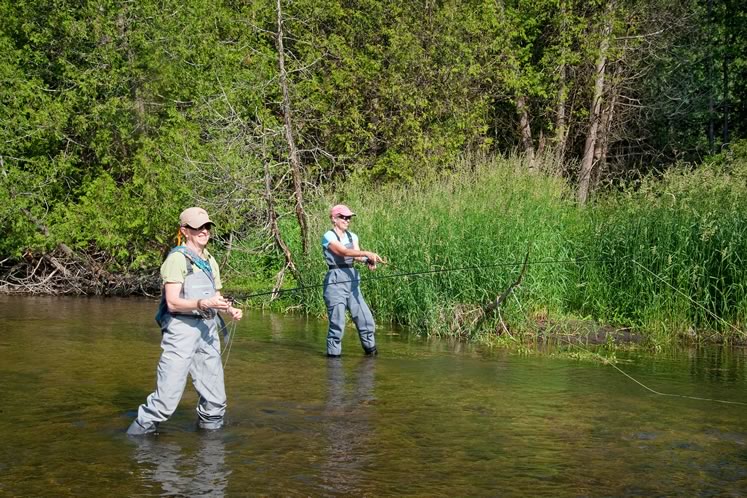
Avid flyfisher Susan Gesner (left) gives fishing novice Nicola Ross a casting lesson on the West Credit. Photo by Rosemary Hasner / Black Dog Creative Arts.
Satisfied, she once again drew back the rod, but this time more slowly and with intention, until the long nylon line formed a graceful arc above her. The smooth, whip-like motion sent sparkling droplets of water high into the sunlit sky. In that moment I felt as though I was on the set of A River Runs Through It. Then I was back on the West Credit. I recalled my dad. The willow trees. His casting. I studied the cedars behind Susan. They hugged the bank of a stream I’d known my entire life. It was as though we were part of nature, in it rather than just observing the river, trees, fish, rocks and blue sky.
As Susan’s long, flexible rod reached the zenith of its backward journey, my friend and coach for the day paused her casting motion for a split second. As she did, the tension on the line increased until, when it was just so, she began drawing her rod forward. The question-mark curves unfurled behind the rod’s tip, and the line caught up and passed by en route to the water’s surface.
If you’ve never cast with a fly rod, you might expect the fly to land first. But that’s not how it happens. Instead, the heavier line nearest the rod’s tip touches the water and then the landing extends forward until the lighter leader (line) touches down – and the fly, tied to a thread-like tippet, finally floats almost to the surface, just as a mayfly might. Just as a fish expects. There’s no snapping of the wrist, no tennis-serve-like power. Casting with a fly rod is about timing and precision. It’s about feel. It’s about art and nature. Sense and sensibility.
When Susan talks about fly fishing, her voice goes all dreamy. She is transported back into a river, rod in hand. Silhouetted by the low sun’s rays on this morning, she was in that reverie. We both were.
Despite my vivid imagination I didn’t have Susan’s skill. My fly tended to plunk onto the water rather than glide down like a feather. “You’re pulling your rod back too fast,” Susan coached. “Don’t forget to pause before bringing it forward,” she added. “Don’t snap your wrist. Let the motion come from your elbow. Keep the rod between 12 o’clock and 2 o’clock.”
In the short 90 minutes we fished, I wasn’t surprised by my lack of technical skill. With practice, I knew I could acquire the feel I needed to land my fly gently on the water’s surface – much as Susan did and as my dad had done all those years ago. What did surprise me was how the time had flown by, and how intent I had been on observing the river, looking for places where the fish might be. I’d been studying the minute details of the landscape. Sure, I had a jolt of excitement, a dash of adrenalin when that third fish jerked my line. But my takeaway – what I finally understood – is that my dad may have driven to the trout club to hone his casting skills and to catch fish, but when he walked down to the river, fly rod in hand, it was to escape into nature.
Fishing Resources
To fish in Ontario, everyone between the ages of 18 and 65 requires a licence – except on four family-oriented weekends a year. You can apply for a licence online at ontario.ca/page/fishing-licence-fees-ontario-residents.
In the streams and rivers of Headwaters, strict limits govern the number and types of fish you can catch and keep. Check the websites of local conservation authorities or provincial parks for information specific to each.
For a general guide to current fishing rules, search “fishing regulations summary” at ontario.ca.
Here are some local clubs and resources:
- Caledon Mountain Trout Club thecmtc.com
- Glen Haffy Fly Fishing Club trca.ca/activities/fly-fishing
- Headwaters Fly Fishing Club on Facebook
- Primrose Trout Farm primrosetroutfarm.com
Related Stories
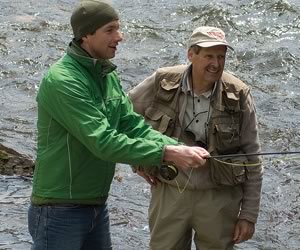
My First Time Fly Fishing
Jun 18, 2009 | | LeisureBecause I love the outdoors, I always thought fishing would be the perfect sport for me.
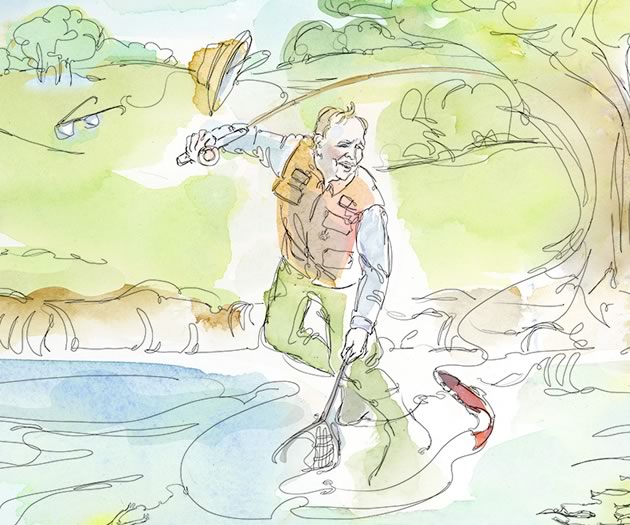
A Fish Story
Jun 20, 2016 | | Fence PostsThen the sun emerged and I saw a glint of gold rim on the gravel bottom.
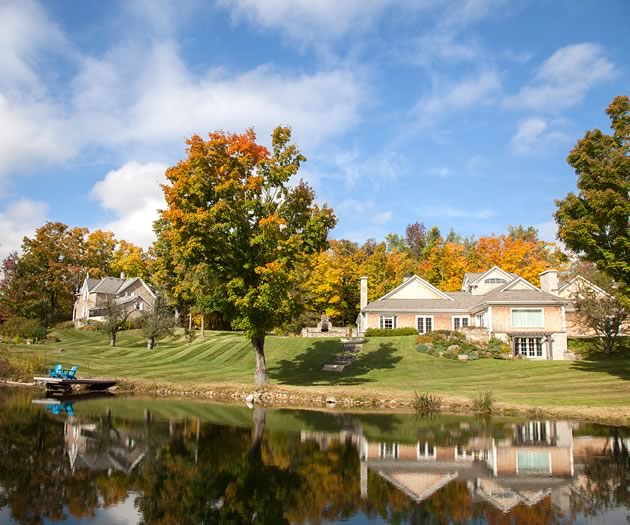
A Family Seat
Sep 16, 2016 | | At Home in the HillsA compound of historic buildings and fishing ponds makes an idyllic gathering place for family and friends.
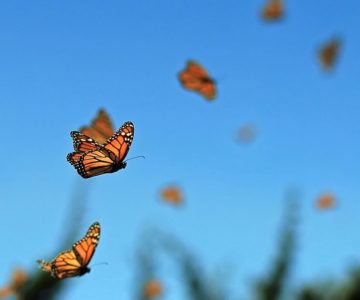
Fall’s Best: The Monarch Butterfly, the Porcupine and the Brook Trout
Sep 16, 2017 | | EnvironmentSavour fall with these 10 wonders of autumnal nature – from insects to constellations.
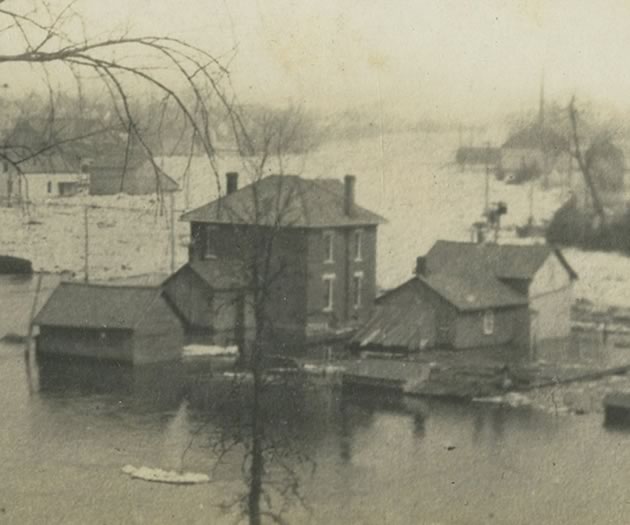
The Grand River – When Your Neighbour is a River
Jun 20, 2016 | | Historic HillsNot only does the Grand River lay out nature’s beauty, it also offers opportunities for recreation, commerce and development. Yet all this comes at a cost, for the Grand can be both friend and foe.
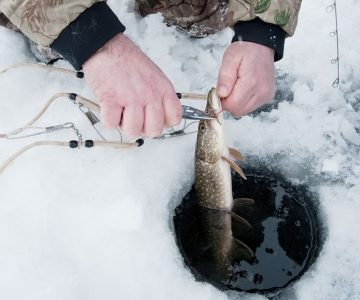
Ice Fishing on Island Lake
Nov 20, 2018 | | LeisureGoing for the big one: At the ice fishing derby on Island Lake, the lucky ones win a prize – or at least go home with supper.









